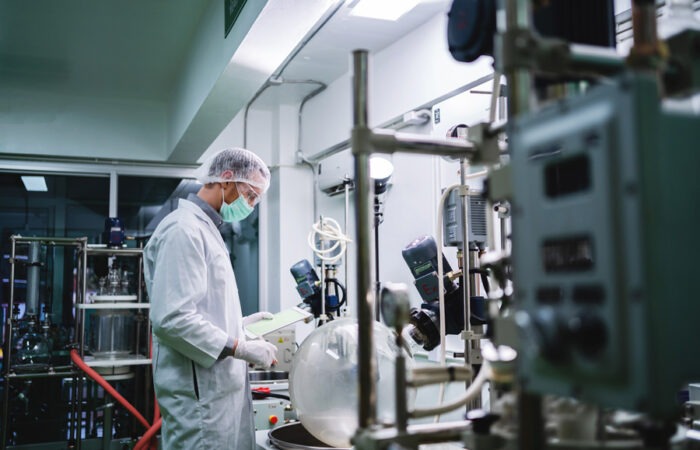CBD has emerged as a non-psychoactive agent in cannabis, stimulating a boom of boutique cannabis products into the medicinal and adult use markets .
The innovative CannaMetrix EC50 Array™ offers a solution to traditional chemical methods of testing cannabis potency, which often fall short in accurately capturing the complex interactions between cannabinoids and the human body.
Find more at https://cannametrix.org/
Read more in Research Outreach
Image credit: Adobe Stock /24k Production
Transcript:
Hello and welcome to Research Pod! Thank you for listening and joining us today.
In this episode we look at the innovative CannaMetrix EC50 Array™ technology, offering a solution to traditional chemical methods of testing cannabis potency, which often fall short in accurately capturing the complex interactions between cannabinoids and the human body. This leads to challenges in identifying relevant medicinal cannabinoids, ensuring consistency in product potency and consumer confidence. By measuring cellular responses to cannabinoids in real-time, this high-throughput method provides valuable insights into a product’s true potency and therapeutic benefits, enhancing efficiency and reliability in the cannabis industry.
Oversite of the cannabis and hemp industry primarily focuses on the measurement and regulation of products based predominantly on the percent composition of delta-9-tetrahydrocannabinol, or THC. THC is one of over one hundred cannabinoids typically found in Cannabis sativa and indica and is best known as a psychoactive agent responsible for the “high” of cannabis. More recently cannabidiol, or CBD has emerged as a non-psychoactive agent in cannabis with its own set of activities in the body. Advances in the ability to identify new types of cannabinoids in cannabis, coupled with increasing precision of plant breeders and cannabinoid extractors, are stimulating a boom of boutique cannabis products into the medicinal and adult use markets with diverse cannabinoid content available to consumers. This is indicative of the ever-evolving nature of both these markets and points to a pivotal moment in the industry’s trajectory as the ability to detect and isolate cannabinoids is outpacing the understanding what role they play in how our bodies function.
CannaMetrix, LLC has secured a patent for its groundbreaking technology, enabling the accurate demonstration of cannabinoids’ genuine potency on the human endocannabinoid system – a naturally occurring physiology in human cells that reacts to plant cannabinoids. This technology provides information explaining the strength of a response anticipated from different amounts of a product, and uniquely shows how multiple cannabinoids in a product work together. This innovative approach empowers the formulation of products with precisely determined, dose-dependent effects on specific cell surface cannabinoid receptors. As a result, C Owen Wolffsmith and Harold C Smith’s research from CannaMetrix, LLC helps consumers make better choices, improves satisfaction, and builds strong loyalty to the product.
Of the many different cannabinoids found in cannabis, each have unique chemical structures and potential effects on the human body. However, measuring the amount of several cannabinoids in a product by existing compliancy testing cannot not fully capture the complex interplay between cannabinoids, their interactions with cell receptors, and consequential effects on human physiology. As a result, consumers face challenges in accurately gauging the potency and therapeutic efficacy of cannabis products.
While the physiologic effects of THC – the primary psychoactive compound in cannabis, responsible for inducing the euphoric ‘high’ commonly associated with marijuana use – and CBD – a non-psychoactive cannabinoid found in cannabis known for its diverse therapeutic properties including anti-anxiety, anti-inflammatory, neuroprotective, and anticonvulsant effects – are widely recognised, scientific literature suggests that numerous minor cannabinoids can also play crucial roles in altering human physiology.
Moreover, the major and minor cannabinoids as well as terpenes acting in concert on the human endocannabinoid system can lead to responses distinct from those observed with individual cannabinoids, underscoring the complexity of cannabis’ effects on the human body.
Despite this growing body of knowledge, the industry’s approach to potency determination remains somewhat rudimentary. Instead of embracing novel or targeted methods of assessing potency, producers often rely on consumer trends to inform product formulation, a reactive approach that may not fully capture the nuances of product potency.
Furthermore, studies conducted by reputable institutions, such as the FDA, NIH, JAMA, and Johns Hopkins, have shed light on discrepancies between labelled and actual cannabinoid content in products, further complicating consumer choice and highlighting the need for more robust quality control measures.
Understanding the historical context of cannabis regulation is crucial for comprehending the current state of the industry. THC’s classification as an illicit substance has historically hindered scientific understanding and discouraged research into the endocannabinoid system, perpetuating misconceptions and impeding progress in the field.
However, as cannabis and cannabis research have gained mainstream acceptance, it has become increasingly evident that the interplay between major and minor cannabinoids is far more intricate than previously assumed, necessitating a paradigm shift in how potency is assessed and understood.
Distinguishing between chemical composition and biologic potency is paramount in accurately assessing the efficacy of cannabis products. While the percentage of THC by weight in a product is often colloquially referred to as its potency, this measure is somewhat arbitrary and does not necessarily correlate with therapeutic efficacy. More importantly the focus on THC as the main component of potency and the psychoactive “high” as the essential measure of potency helps keep cannabis science and medicine locked in a small corner of the space the industry could occupy by not placing emphasis on multiple cannabinoids and their unique contributions to changes in physiology.
The cannabinoid compounds found in cannabis interact with proteins on the surface of cells, known as receptors, which serve as sensors — transducers of information –to the interior of cells to modify their biochemistry. Cannabinoid receptors, therefore, are the first to sense what cannabinoids are present and communicate this information to the endocannabinoid system – a network in the human body involved in regulating various physiological processes at the level of cells and tissues.
Biologic potency, measured by CannaMetrix’s EC50 Array, utilizes rapid and cost-effective laboratory practices to reveal intensity of the endocannabinoid response to any amount of a tested compound. This test can reveal the unique potencies of cannabinoid blends not observed from measuring single cannabinoids at a time, thus offering a more nuanced understanding of a product’s potency and its effects on the endocannabinoid system.
Each cannabinoid has its own potency and effectiveness, with some cannabinoids capable of very high levels of effectiveness at low concentrations. When these minor composition cannabinoids are combined with other cannabinoids in specific blends, the collective potency experienced by a consumer can vary significantly from what might be expected based only on percent composition of major cannabinoids like THC or CBD. Therefore, evaluating how human cells respond to the particular composition in a cannabis product as the basis for assessing a product’s potency considers the contribution to potency of all cannabinoids underscoring the significance of the CannaMetrix technology.
The next level of complexity which obscures the assessment of potency using only on chemical composition is that both major cannabinoids and those overlooked as minor due to their low percent composition in a product, can have major impacts on each other by changing their interaction with the endocannabinoid system. The biologic potency perceived by a consumer taking products with near identical major cannabinoid composition but varying in their minor cannabinoid composition could therefore be completely different from their expectation based on the product labelling. Analogously, cannabinoid products resemble jars of assorted jellybeans, where legal limits dictate bean colours per jar. While colour represents chemical testing, flavour, reflecting combinations of colours, is assessed through biologic testing.
Innovative methods, like the CannaMetrix EC50 Array™, are closing the gap between chemical composition and biological potency in cannabis products. Developed by CannaMetrix, a leading expert in cannabinoid potency assessment, this technology provides a streamlined approach to gauging the biologic impact of cannabis.
By using cells engineered in the laboratory to produce a quantifiable and dose-dependent human endocannabinoid response to cannabinoids, the EC50 Array™ swiftly measures cellular responses to cannabinoids in real-time. This process evaluates the concentration of cannabinoids required to trigger a half-maximal response, known as an E-C-50, offering a detailed description of product’s true potency, potential therapeutic benefits, and enabling an understanding that pairs chemical composition with biologic potency.
In essence, characterizing a product based on its EC50 on cannabis receptors is essential in determining the effectiveness of the product in eliciting a desired response from the cells, which can then be correlated with its potential effects on the human body. Labelling each product for its EC50 on cannabis receptors can be used as a product potency characteristic that becomes a quality control point ensuring batch-to-batch consistency. This in turn provides producers with a metric to guide plant genetics, develop and vet extraction conditions, and product formulations that ensure consistency and enhance consumer trust. While chemical analysis remains vital for quality control, biological potency testing is pivotal in guaranteeing the effectiveness and reliability of cannabis products and the industry’s future economic growth.
By embracing methods of potency determination focused on biology, producers can better meet the needs of consumers and provide products that deliver predictable and quantifiable effects, ultimately advancing the cannabis industry and enhancing public health and safety.
The cannabis industry is undergoing broadscale expansion with its evolving legal status. Consequently, a critical mass of technology to produce plant extracts and synthetic cannabinoids has flooded the market space with new products. Largely backed by industry status quo using anecdotal accounts of product performance, no direct testing or validation of biological potency for new products is introduced to consumers. With the pending US federal reclassification of cannabis to schedule III, controlled drug, producers will need to adhere to higher standards associated with FDA oversight.
The researchers emphasise that predicting the interaction between plant cannabinoids and the human endocannabinoid system, crucial for the qualitative experience, goes beyond mere percent cannabinoid composition. A true measure of how combinations of cannabinoids of varying percent composition will trigger the endocannabinoid system can only be quantified through human biologic endpoints. Current regulatory practices focus on quantifying specific cannabinoid content by mass percent. This principally establishes a threshold for THC-mediated intoxication; however,
chemical testing alone fails to provide sufficient insight into a product’s performance, especially for those marketed for effects other than THC’s psychoactivity.
CannaMetrix, LLC’s EC50 Array™ has already begun to unveil unexpected potencies in cannabinoid blends, transcending the biological potency measured for individual cannabinoids. This discrepancy adds further uncertainty as to what consumers are really getting when they purchase products vetted by chemical composition analyses alone. The adoption of biologic potency testing will provide the cannabis industry with a rapid, low cost and robust means of evaluating plant growth, plant extracts, and synthetic blends before bringing products to market.
CannaMetrix, LLC is seeking stake holders in the hemp and cannabis industries who wish to advance their understanding of their product’s applications through direct biologic potency testing and help differentiate their cannabinoid product lines for consumer choice. CannaMetrix, LLC has patented the use of human cell potency testing and the EC50 Array and has developed a trade mark where by plant breeders, processors and consumers can identify products that have been tested for their potency in the endocannabinoid system. This technology will allow for the formulation of products with known dose-dependent outcomes, on specific cell surface receptors, and result in informed consumer choice, satisfaction, and product loyalty. CannaMetrix is open for business and is seeking strategic partners in the industry through testing services and licensing agreements.
That’s all for this episode – thanks for listening and stay subscribed to Research Pod for more of the latest science.
See you again soon.




